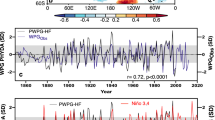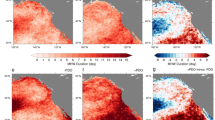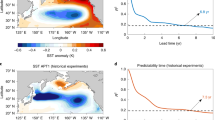Abstract
The Pacific Walker circulation is a large overturning cell that spans the tropical Pacific Ocean, characterized by rising motion (lower sea-level pressure) over Indonesia and sinking motion (higher sea level-pressure) over the eastern Pacific1,2. Fluctuations in the Walker circulation reflect changes in the location and strength of tropical heating, so related circulation anomalies have global impacts3,4. On interannual timescales, the El Niño/Southern Oscillation accounts for much of the variability in the Walker circulation, but there is considerable interest in longer-term trends and their drivers, including anthropogenic climate change5,6,7,8,9,10,11,12. Here, we examine sea-level pressure trends in ten different data sets drawn from reanalysis, reconstructions and in situ measurements for 1900–2011. We show that periods with fewer in situ measurements result in lower signal-to-noise ratios, making assessments of sea-level pressure trends largely unsuitable before about the 1950s. Multidecadal trends evaluated since 1950 reveal statistically significant, negative values over the Indonesian region, with weaker, positive trends over the eastern Pacific. The overall trend towards a stronger, La Niña-like Walker circulation is nearly concurrent with the observed increase in global average temperatures, thereby justifying closer scrutiny of how the Pacific climate system has changed in the historical record.
This is a preview of subscription content, access via your institution
Access options
Subscribe to this journal
Receive 12 print issues and online access
$209.00 per year
only $17.42 per issue
Buy this article
- Purchase on Springer Link
- Instant access to full article PDF
Prices may be subject to local taxes which are calculated during checkout




Similar content being viewed by others
References
Bjerknes, J. Atmospheric teleconnections from the equatorial Pacific. Mon. Weath. Rev. 97, 163–172 (1969).
Gill, A. E. Some simple solutions for heat-induced tropical circulation. Q. J. R. Meteorol. Soc. 106, 447–462 (1980).
Horel, J. D. & Wallace, J. M. Planetary-scale atmospheric phenomena associated with the Southern Oscillation. Mon. Weath. Rev. 109, 813–829 (1981).
Kousky, V. E., Kagano, M. T. & Cavalcanti, I. F. A review of the Southern Oscillation: Oceanic–atmospheric circulation changes and related rainfall anomalies. Tellus A 36, 490–504 (1984).
Vecchi, G. A. et al. Weakening of tropical Pacific atmospheric circulation due to anthropogenic forcing. Nature 441, 73–76 (2006).
Meng, Q. et al. Twentieth century walker circulation change: Data analysis and model experiments. Clim. Dynam. 38, 1757–1773 (2012).
Knutson, T. R. & Manabe, S. Time-mean response over the tropical Pacific to increased CO2 in a coupled ocean–atmosphere model. J. Clim. 8, 2181–2199 (1995).
Vecchi, G. A. & Soden, B. J. Global warming and the weakening of the tropical circulation. J. Clim. 20, 4316–4340 (2007).
Held, I. M. & Soden, B. J. Robust responses of the hydrological cycle to global warming. J. Clim. 19, 5686–5699 (2006).
Sohn, B. J. & Park, S-C. Strengthened tropical circulations in past three decades inferred from water vapor transport. J. Geophys. Res. 115, D15112 (2010).
DiNezio, P. N., Vecchi, G. A. & Clement, A. C. Detectability of changes in the walker circulation in response to global warming. J. Clim. http://dx.doi.org/10.1175/JCLI-D-12-00531.1 (2013).
Tokinaga, H., Xie, S-P., Deser, C., Kosaka, Y. & Okumura, Y. Slowdown of the Walker circulation by tropical Indo–Pacific warming. Nature 491, 439–443 (2012).
Ropelewiski, C. F. & Halpert, M. S. Precipitation patterns associated with the high index phase of the Southern Oscillation. J. Clim. 2, 268–284 (1989).
Lyon, B. & DeWitt, D. G. A recent and abrupt decline in the East African long rains. Geophys. Res. Lett. 39, L02702 (2012).
Gastineau, G. & Soden, B. J. Evidence for a weakening of tropical surface wind extremes in response to atmospheric warming. Geophys. Res. Lett. 38, L09706 (2011).
Merrifield, M. A. & Maltrud, M. E. Regional sea level trends due to Pacific trade wind intensification. Geophys. Res. Lett. 38, L21605 (2011).
Walker, G. T. Correlation in seasonal variations of weather, IX. A further study of world weather. Mem. India Meteor. Dept. 24, 275–333 (1924).
Betts, A. K. & Ridgway, W. L. Climatic equilibrium of the atmospheric convective boundary layer over a tropical ocean. J. Atmos. Sci. 45, 2621–2641 (1989).
Wentz, F. J., Ricciardulli, L., Hilburn, K. A. & Mears, C. A. How much more rain will global warming bring? Science 317, 233–235 (2007).
Allen, M. R. & Ingram, W. J. Constraints on future changes in the hydrological cycle. Nature 419, 224–228 (2002).
Allan, R. P. & Soden, B. J. Atmospheric warming and the amplification of precipitation extremes. Science 321, 1481–1484 (2008).
John, V. O., Allan, R. P. & Soden, B. J. How robust are observed and simulated precipitation responses to tropical ocean warming? Geophys. Res. Lett. 36, L14702 (2009).
Liepert, B. G. & Previdi, M. Do models and observations disagree on the rainfall response to global warming? J. Clim. 22, 3156–3166 (2009).
Durack, P. J., Wijffels, S. E. & Matear, R. J. Ocean salinities reveal strong global water cycle intensification during 1950 to 2000. Science 336, 455–458 (2012).
Santer, B. D. et al. Separating signal and noise in atmospheric temperature changes: The importance of timescale. J. Geophys. Res. 116, D22105 (2011).
Barnston, A. G., Chelliah, M. & Goldenberg, S. B. Documentation of a highly ENSO-related SST region in the equatorial Pacific. Atmos.-Ocean. 35, 367–383 (1997).
Solomon, A. & Newman, M. Reconciling disparate 20th century Indo–Pacific ocean temperature trends in the instrumental record. Nature Clim. Change 2, 691–699 (2012).
Cane, M. A. et al. Twentieth century sea surface temperature trends. Science 275, 957–960 (1997).
Fu, Q., Manabe, S. & Johanson, C. M. On the warming in the tropical upper troposphere: Models versus observations. Geophys. Res. Lett. 38, L15704 (2011).
Clement, A. C., Seager, R., Cane, M. A. & Zebiak, S. E. An ocean dynamical thermostat. J. Clim. 9, 2190–2196 (1996).
Bretherton, C. S., Widmann, M., Dymnikov, V. P., Wallace, J. M. & Bladé, I. The effective number of spatial degrees of freedom of a time-varying field. J. Clim. 12, 1990–2009 (1999).
Acknowledgements
We thank Z-Z. Hu and W. Ebisuzaki for their comments and suggestions, and L. Zhang for directing us to some of the data. We also thank NOAA ESRL/PSD and the National Energy Research Scientific Computing Center for providing several data sets on their websites.
Author information
Authors and Affiliations
Contributions
All authors contributed to the ideas in this paper. M.L.L. carried out the analysis and wrote the paper. S.L. and B.L. offered their help with interpreting the analysis and also edited the paper.
Corresponding author
Ethics declarations
Competing interests
The authors declare no competing financial interests.
Supplementary information
Supplementary Information
Supplementary Information (PDF 1590 kb)
Rights and permissions
About this article
Cite this article
L’Heureux, M., Lee, S. & Lyon, B. Recent multidecadal strengthening of the Walker circulation across the tropical Pacific. Nature Clim Change 3, 571–576 (2013). https://doi.org/10.1038/nclimate1840
Received:
Accepted:
Published:
Issue Date:
DOI: https://doi.org/10.1038/nclimate1840
This article is cited by
-
Forced changes in the Pacific Walker circulation over the past millennium
Nature (2023)
-
Drivers and impacts of Eastern African rainfall variability
Nature Reviews Earth & Environment (2023)
-
Satellite-observed strong subtropical ocean warming as an early signature of global warming
Communications Earth & Environment (2023)
-
Local meridional circulation changes contribute to a projected slowdown of the Indian Ocean Walker circulation
npj Climate and Atmospheric Science (2022)
-
Interbasin and interhemispheric impacts of a collapsed Atlantic Overturning Circulation
Nature Climate Change (2022)



